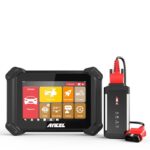For owners of the classic 1998 BMW E39, understanding the diagnostic capabilities of your vehicle is crucial for maintenance and repair. A common question arises: does a 1998 BMW E39 have an OBD2 port? The answer is a bit nuanced due to BMW’s transition period with On-Board Diagnostics. Let’s delve into the specifics of diagnostic connectors in BMWs of this era, particularly the E39 5-Series.
BMW Diagnostic Connectors: Round Connector Era
Prior to the widespread adoption of OBD2, BMW, like many European manufacturers, utilized a proprietary 20-pin round diagnostic connector. This connector is typically found in the engine compartment, often near the firewall or strut tower. Dating back to 1988, BMW implemented this round connector across various models as their primary diagnostic interface.
For BMW E39 models manufactured before the year 2001, including the 1998 BMW E39, the round 20-pin connector was the standard diagnostic port. This means that for your 1998 E39, you will most likely find this round connector under the hood.
Here is a 540i (E39)
This round connector provided access to various vehicle systems, though the capabilities and protocols differed from the later OBD2 standards. It’s important to note that while these connectors are diagnostic ports, they require specific adapters and scan tools compatible with BMW’s diagnostic protocols of that time.
The Transition to OBD2 and the 1998 E39
In 1996, OBD2 (On-Board Diagnostics II) became mandatory in the United States for all new cars. BMW began incorporating OBD2 connectors in their North American market vehicles around this time. However, initially, BMW’s OBD2 implementation was limited, primarily offering access only to the engine control module (ECM).
Despite the introduction of OBD2 in some 1996 and later BMW models, the 1998 BMW E39 predominantly retained the round diagnostic connector as its main, and often only, diagnostic interface. Therefore, if you are looking for a standard 16-pin OBD2 port under the dashboard of your 1998 BMW E39, you will likely not find one.
Connecting to Your 1998 BMW E39 for Diagnostics
To perform diagnostics on your 1998 BMW E39, you will need to locate the 20-pin round connector in the engine bay. To interface with this connector using modern OBD2 scan tools, you will require a round-to-OBD2 adapter cable. This adapter bridges the gap between the older BMW connector and the standard OBD2 interface, allowing you to use a wide range of diagnostic equipment.
Here is a 325i (E46)
When selecting scan tools and adapters, ensure they are compatible with the diagnostic protocols used by BMW in 1998. While basic OBD2 readers might offer limited engine diagnostics via an adapter, more advanced BMW-specific scan tools will provide comprehensive access to various systems, including ABS, airbags, transmission, and more.
Later E39 Models and OBD2
It’s worth noting that BMW E39 models produced from 2001 onwards transitioned to using the standard 16-pin OBD2 connector as the primary diagnostic port, typically located under the dashboard on the driver’s side. This change streamlined diagnostics for later E39s, aligning them with industry standards.
However, for your 1998 BMW E39, remember to look for the round connector under the hood and utilize appropriate adapters and scan tools for effective diagnostics and maintenance. Understanding this distinction is key to properly servicing your classic BMW E39.
